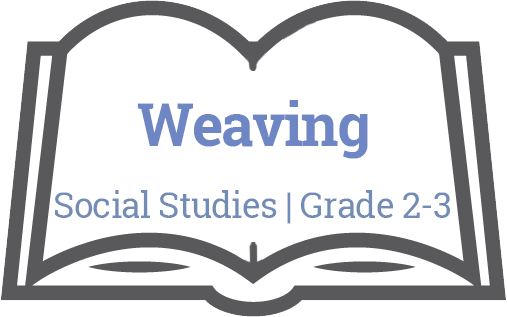
Unit Plan: Weaving
Social Studies / Grade 2-3

Big Ideas
Canada is made up of many diverse regions and communities. (Grade 2)
Indigenous societies throughout the world value the well-being of the self, the land, spirits, and ancestors. (Grade 3)
Concepts:
- Perspective
- Function
Essential Questions
Students will keep considering…
- How are the land and environment important to Canadian and Indigenous communities past and present?
- How are woven textiles made?
Evaluative Criteria
Rubric
- Student will be able to expertly describe the importance of the land and environment.
- Student can expertly create a woven piece that includes even tension throughout.
- Student is able to clearly describe how woven textiles are made.
Monitoring Progress
Teacher will monitor progress:
Teachers can monitor progress through ongoing formative assessment including but not limited to:
- Students could write, draw or share reflections on their learning throughout this process that teachers could assess
- Teachers could assess the student’s woven product
Resources
WEBSITES
- In the Art Room: Tree Weaving with Third Grade
- Hiding in Plain Sight: Discovering the Métis Nation in the Collection of Library and Archives Canada
TEXTS
- “The Red Sash” by Jean E. Pendziwol
Reflection
How will teachers and their students reflect on and evaluate the completed project?
Teacher Reflection
- What aspects of the unit went well?
- What did students struggle with
- What did you struggle with?
- What would you add/revise the next time you taught this unit?
- Were there any unintended outcomes?
- Were students engaged?
Downloads
Unit Overview
Subject
Social Studies
Topic
Weaving
Unit Overview
In this unit, students will learn about the ancient craft of “weaving.” Weaving has been used by numerous cultures in Canada both historically and presently. Here, students will learn about the cultural significance of Métis sash weaving and their connection to the land. Students will develop knowledge and skills around the process of weaving and will finish by creating a Métis-inspired woven tree scene.
Important Traditional Knowledge for this unit:
- Metis communities began in the early 1700s when French and Scottish fur traders married aboriginal women (often Cree, and Anishinabe). “Distinct Métis communities developed along the fur trade routes. This Métis Nation Homeland includes the three Prairie Provinces (Manitoba, Saskatchewan, Alberta), as well as, parts of Ontario, British Columbia, the Northwest Territories and the Northern United States. (Library and Archives of Canada) “Metis sashes were worn by men and helped them to survive in the bush. Originally the colours used were green, red, tan and brown, but now they use green, red, blue, gold, and white. The foot-long tassels could be used to repair snowshoes, dog harnesses, bridles, make snares, repair clothing, carry canoes or heavy sacks (like a sling) and most importantly wrap around their waists to stay warm. The sashes were originally 12-16 feet long and made by hand. The finger-weaving process would take one person 60 to 100 hours to produce. They traditionally used the arrow pattern and it is still used today. (adapted from “Little Metis and the Metis Sash” by D.L. Delaronde)
Important Mathematical Knowledge for this unit:
- Basic patterns can be taught through weaving. Think about the process of weaving, over, under, over under, this represents an AB pattern. Students can also investigate the colour patterns. The horizontal patterns may be AB, AB if you go over/under or they could be AAB, AAB if you go over two and under one. The vertical colour patterns can also be examined once the weaving is done. If you use one colour on each row and cycle through three colours in order, this may represent and ABC pattern. The math conversations are endless!
Grade
2-3
Unit Duration
Minimum: 2 weeks
Related Big Ideas
N/A

The following resources are made available through the British Columbia Ministry of Education. For more information, please visit BC’s New Curriculum.
Big Ideas
The Big Ideas consist of generalizations and principles and the key concepts important in an area of learning. The Big Ideas represent what students will understand at the completion of the curriculum for their grade. They are intended to endure beyond a single grade and contribute to future understanding.
Core Competencies
 Communications Competency
Communications Competency
The set of abilities that students use to impart and exchange information, experiences and ideas, to explore the world around them, and to understand and effectively engage in the use of digital media
 Thinking Competency
Thinking Competency
The knowledge, skills and processes we associate with intellectual development
 Social Competency
Social Competency
The set of abilities that relate to students’ identity in the world, both as individuals and as members of their community and society
Curricular Competencies & Content
Curricular Competencies are the skills, strategies, and processes that students develop over time. They reflect the “Do” in the Know-Do-Understand model of curriculum. The Curricular Competencies are built on the thinking, communicating, and personal and social competencies relevant to disciplines that make up an area of learning.
Additional Resources
First People's Principles of Learning
To read more about First People’s Principles of Learning, please click here.
For classroom resources, please visit the First Nations Education Steering Committee.
